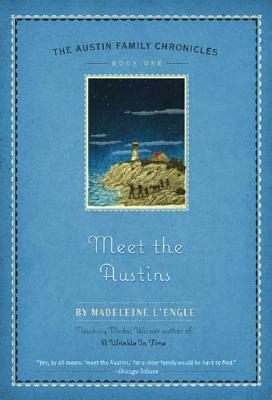In 1960, Madeleine L’Engle published Meet the Austins, the first book in a series she would continue to write for 34 years. Largely centered on the insecurities and uncertainties of its protagonist, Vicky Austin, the warm, loving family series would take her from age twelve to her late teens. According to L’Engle’s family, the books contained several autobiographical elements, and L’Engle herself identified with Vicky in several interviews, making these books among her most personal works.
Two notes: one, my edition of Meet the Austins includes the Anti-Muffins chapter, a chapter removed from the 1960 edition, printed separately in 1980, and restored in contemporary editions. Two, the Austin family series is where the timeline for the L’Engle books stops making any sense whatsoever, mostly because the series was written over a 34 year period. In the first book, Vicky Austin is 12, or about one or two years younger than Meg Murry, who would make her first appearance in A Wrinkle of Time the following year. By the fourth book, Vicky Austin is 18, or about two years older than Polly O’Keefe Meg Murry’s daughter. Fortunately, none of the Austin books or the Murry books are tied to a specific year, so this can be handwaved a bit, either by imagining that a A Wrinkle in Time is set in the 1950s and the Austin books in the 1970s, or by accepting that L’Engle was just not a believer in linear time and the Murrys are time travellers. Onwards!
Meet the Austins opens with a brief introduction to the main members of the family: the father, a busy gynecologist and his wife, a homemaker; the oldest son, John, brilliant and intellectually intimidating, creating some of Vicky’s insecurities; Vicky, the narrator; Suzy, her beautiful younger sister, who unintentionally makes Vicky feel ugly and awkward; Rob, a cute four year old; and various animals, including a poodle, a Great Dane and various cats. The animals are marvelous—I’m only sorry that they don’t make it through the entire series—as are the various interactions between the siblings, who, naturally, fight and find one other deeply irritating.
This excerpt from an Austin Christmas story, The Twenty-Four Days Before Christmas, nicely showcases all of the strengths and weaknesses of Vicky as a character. She is remarkably and realistically self-centered, even for a seven year old (forget that my mother is about to give birth! what about dinner!), jealous of her siblings, and deeply uncertain of herself. The Vicky in Meet the Austins is a little older, but she is still the same Vicky.
Into this family arrives a very angry little girl, Maggy, who has just lost her parents in a tragic accident. It’s not at all clear what will happen to Maggy—her parents failed to leave an iron-clad will, and the main guardian named by the parents is in no position to take in a child. This uncertainty does not make Maggy’s life any easier, and to worsen matters, she comes from a considerably wealthier family, creating further adjustment problems. Nonetheless, the Austins welcome her and offer her a home, at least temporarily.
This plot is pulled directly from L’Engle’s real life: she and her husband took in and later adopted the child of friends who died tragically young. This probably explains why so many of the scenes feel so genuine, particularly in the not always positive responses from the kids. They know that they ought to be nice and understanding, but, since they’re kids, they sometimes fail. This results in some major family disruptions, not helped by the arrival of measles, well meaning attempts to help, and the arrival of some very bad tempers—which in turn leads to some other accidents.
Throughout this, L’Engle maintains a warm, accepting tone, extended to all of the children and Maggy. She is able to do this, despite a not always sympathetic first person narrative, I think, because for all of her insecurities and worries, Vicky is still part of a very loving family, and that knowledge breathes through her voice. Vicky’s parents also take more than one moment to explain matters from other viewpoints, helping not just Vicky, but readers, understand why Maggy so frequently acts badly. The deleted and then reinserted chapter I mentioned adds to the theme of understanding by chatting about accepting those who may not fit society’s pre or current expectations.
The end result is a warm, happy book, with characters easy to identify with, with a few moments of tension scattered here and there. If Vicky, even with the help of her parents and brother, never quite has the same moments of insight that Camilla and Flip manage to reach on their own, and never matures as much, she is also younger, and in a safer place. She has time.
The Austin family series originally remained strictly rooted in the real world, but after L’Engle became known as a fantasy and science fiction author, one or two otherwordly elements began to creep into the series. Even then the series maintained its more mainstream roots, never reaching too far into speculative fiction. This may be one reason why the series is somewhat less known. A second reason may be the 34 year timespan L’Engle needed to write five books, which not surprisingly created some inconsistencies. For example, a toy broken in the first book reappears, miraculously never broken, in the second, and similar small inconsistencies abound. And if none of these inconsistencies would bother child readers, they are more problematic for the teenage audience of the later books of the series. I’ll be noting a few more of these as we go through the series.
Mari Ness lives in central Florida, where she is prepping up for the higher math that will be mentioned in the next post, if by “prepping” we mean “consuming fudge.”










